|
Erie Canal, the Greatest
Accomplishment of the Men and Women of New York State
By John R. Groves
Itís April 15, 1817 and the Council of Revision has an important
decision to make. A few years earlier, during the War of 1812, the
British tried to regain the colonies it lost during the American
Revolution of 1776. Fresh in the minds of federal politicians were
the attempted sack of Washington and the subsequent burning of the
White House.
Council of Revision was a body of New York government that reviewed
bills passed and had the power of veto. The council consisted of
five chancellors who voted on a bills fate. The canal bill was
deadlocked, two for and two against. The deciding vote was held by
Chancellor Kent.
Chancellor Kent hated war. He was opposed to the notion that state
money be apportioned to a war that was only speculative. Chancellor
Kent was not swayed or particularly impressed with the threat of
war.
"Gentlemen," said Chancellor Kent, "if we must choose between the
canal and war, I am in favor of the canal!" In a single vote the
most important legislation in the history of New York was passed!
Natures Role in the Canal
This story actually starts tens of thousands of years ago. It starts
with the glaciers that passed over our state. During the last
glacier the state was literally prepared for the canals passage.
As the huge ice fields receded they accomplished two major tasks.
First they planned out lowlands bordering the south shore of Lake
Ontario. This lowland region extends from Lake Eire east to the
Appalachian Mountains.
Second, tremendous amounts of melt water from the west were
channeled through the Appalachian Mountains at a place now called
Little Falls. This created melt channel happens to be the only break
in a vast chain of the Appalachians that stretches from Quebec to
Georgia. Through a geologic process, a natural corridor was created
from the Hudson Valley to Lake Erie.
First Thoughts for a Canal
Early explorers traveled up the Hudson River and discovered the
Mohawk River. This River traveled from east to west and provided an
early form of water transportation. Boats navigated the river bit
were limited to size because of the rivers rapids and falls.
Visionaries imagined as early as the late 1600ís navigational
improvements but were largely ignored. Even George Washington,
around 1750, while surveying the region thought a canal was
possible.
Transportation in the late 1700ís and early 1800ís was abysmal.
There were no all weather roads and those wishing to transport goods
and raw materials were severely limited by wagons and relatively
small boats. This hardship concentrated our countries population
centers along the eastern coast and effectively opposed any serious
development of the vast lands west.
There must be a way! There must be a way to move goods, raw
materials and people to populate our vast western frontier. If this
continues to be difficult or impossible, manifest destiny was only a
wild dream.
In New York (ca. 1807) a man was running from debt. His business was
ruined by the high cost of transporting manufactured goods. He and
his partner fled New York to Pennsylvania, to escape imprisonment.
Jesse Hawley, being a man of great integrity, returned to New York
and was sent to the Canandaigua Debtors Prison. While imprisoned he
wrote a number of essays about the notion that a canal could be dug
from Albany to Lake Erie. These articles, under the pen name of
Hercules, influenced many New Yorkers. Especially those engaged in
manufacturing, shipping and DeWitt Clinton, then Mayor of New York
City.
A Man of Vision

DeWitt Clinton was strongly influenced by the concept of having a
canal transverse the state and by doing so open a vast western
frontier. He envisioned tremendous growth in industry, agriculture
and ultimately the growth of New York City into a world-class
seaport. He based his complete campaign for governor on the benefits
of a canal. DeWitt Clinton won the election with the biggest margin
in New York history.
The Greatest Public Works Project of its Time Begins
On July 4, 1817 at Rome New York the canal began. There was a
fantastic celebration where the first shovel of dirt was dug and the
canal began. The excitement was so great witnesses later said,
"Öthat men were grabbing shovels and digging, as if the canal could
be completed in a single dayÖ!".
The first Erie Canal, there were at least three enlargements,
traveled from Albany to a place called Black Rock, near present day
Buffalo. Men who had little or no knowledge of civil engineering
designed much of the canal. The workers who dug the canal came from
many walks of life. Some from Europe worked on the canal to
accumulate enough money to start lives of their own in a free
nation. 363 miles were completed through virgin forests, over raging
rivers and vast valleys. When completed it was often referred to as
the Eighth Wonder of the World, not a trivial idea at that time.
Opening of the Canal
The Erie Canal was completed eight years later in the fall of 1825.
Even before completion the canal was a great success. Already over
$1,000,000 in tolls had been collected!
The celebration called the Wedding of the Waters was to be symbolic
of the impact this canal would have on New York State, the nation
and the world. Water from all parts of the world were collected,
artifacts symbolizing early America and many dignitaries traveled
east starting on October 26, 1825 along the path of the new canal.
When the mules set off east a cannon was fired. All along the new
canal cannons were placed in earshot, so that when one was heard the
next was fired. This relay continued all the way to New York City,
officially announcing that the Erie Canal was open and dignitaries
were on their way.
When DeWitt Clinton arrived at New York City the final ceremony was
completed. He poured into New York Harbor, near Sandy Hook, the
waters collected from the world as a symbolic Marriage of the
Waters. The inner seas of the Midwest (The Great Lakes) now were
directly connected to all the ports of the world. The greatest
public works project of its time was now completed.
Success Breeds Success
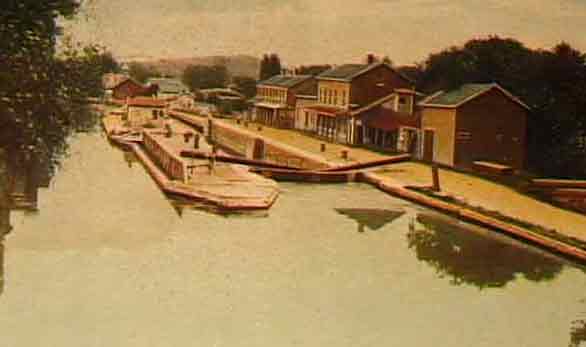
In less than ten years the entire project was paid for through
tolls. The traffic on the canal was so congested that plans were
being made for improvements. These included greater boat capacities,
less locks and a shorter canal by removing many loops. The First
Enlargement took place over many years, from about 1825 until the
turn of the twentieth century. Much had been done, the canal was
deepened to seven feet and the channel widened. Near the end of this
period locks were lengthened and doubled. The canal literally
developed upstate New York, provided a means for many to immigrate
to the western frontier and in the end made New York the Empire
State.
Dark Clouds on the Horizon
The Erie Canal began before the industrial revolution. Goods and
people moved from place to place slowly. Animal power provided the
means for overland travel, the canal made animals much more
efficient. But as the years passed new inventions, such as steam
power would replace animal power.
The Erie Canalís greatest threat was the railroads. They were faster
and could travel from point to point without dependence on water
resources. Railroads were not limited by weather and could deliver
people and products to nearly any location. This was certainly a
serious threat to the canals.
In the late 1860ís tolls on the canal were eliminated to help canal
companies to continue operations. This was helpful, but the writing
was clearly on the wall. Canals was obsolete.
The Last Harrah
In 1905 New York State approved a final enlargement of the canal. It
was to be called the New York State Barge Canal. This canal was to
be the state of the art with electrically powered locks and a
channel that would carry huge amounts of cargo. It replaced the
earlier canals and was completed around 1917.
The new canal was marginally successful. Rail and highway
transportation essentially took all business from the canal.
Yet, even though the present canal isnít used to transport goods, it
still serves a vital roll in the state. In the lowlands of upstate
New York it is a vital water control facility preventing countless
floods from occurring, especially during the spring months. When
floods are not threatening, the canal regulates the levels of the
Finger Lakes.
A New Canal for New Yorkers and the World
Beginning as early as the 1960ís people have had visions that our
canal could serve another purpose. Like many canals in Europe our
canal could become a world-class recreational asset. To this end
public and private segments of New York State have combined efforts
to convert this valuable asset. Today along the New Erie Canal are
parks, trails, bed & breakfasts and vacation opportunities for
everyone. Communities along the canal recognize this prospect and
have made huge improvements.
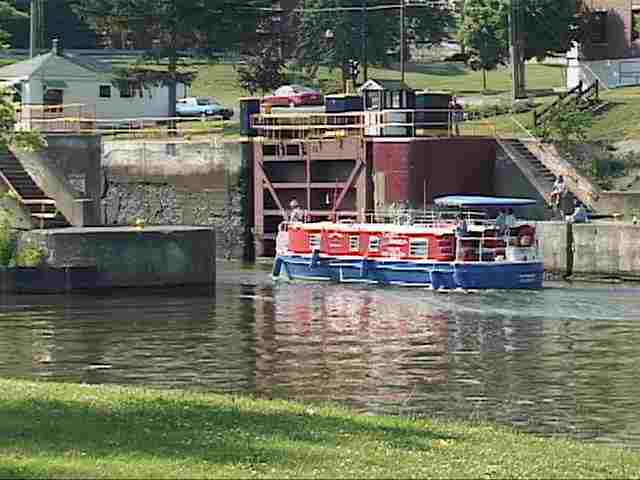
We in New York State welcome visitors to our New Erie Canal. Come to
enjoy our walking/bicycle trails, the parks, and the fabulous places
to stay and dine. The Erie Canal is a legend to be discovered. Much
more than has been shared here is out there to be learned. Make New
York State and the New Erie Canal your next destination!
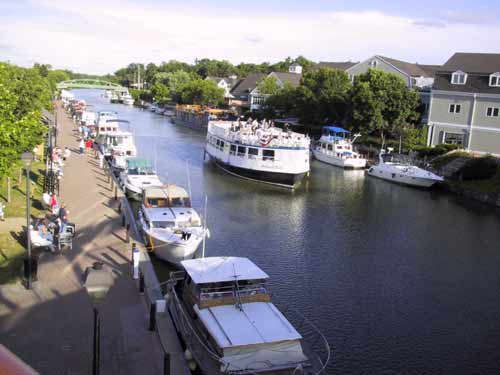
The Wedding of
the Water 1991
In October 1991, there was a 14-day re-enactment of the
Wedding of the Waters voyage of 1825. It was done by the group
called E.R.I.E - Erie's Restoration Interests Everyone. Concerned
about the condition of the canal, and also, its potential, Mark
DeCracker of Lyons founded the group in 1988. A tug boat ^minus the
hoggee (muleskinner) alongside on a towpath_ pulled a museum raft
which served as a stage for entertaining and educating. DeCracker
dressed in period costume and alternately portrayed DeWitt Clinton
and Jesse Hawley. The history of the Erie Canal was shared with many
canalside visitors, particularly children in school groups, on the
27 stops the tug made.
Once again Lake Erie water was carried and dumped into New York
Harbor.
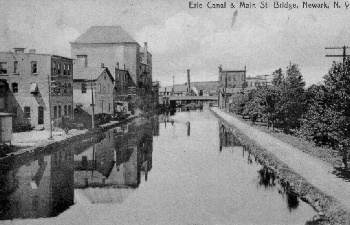 This
20th Century Wedding of the Waters publicized the pending fate of
the canal. This
20th Century Wedding of the Waters publicized the pending fate of
the canal.
Eleven days after the completion of the re-enactment, on November
5, 1991, the NYS voters passed an amendment to SAVE the canal. The
amendment authorized the State (1) to grant leases of canal lands;
(2) use all funds derived, for maintenance, construction,
reconstruction, development or promotion of the canal; (3) to allow
tolls on persons or property transported; (4) to establish certain
provisions with respect to contracts for work or materials.
The following year the entire NYS Barge Canal System of which
the Erie is the major part, was transferred from the jurisdiction of
the State Department of Transportation to the NYS Thruway Authority.
As we approach the 21st Century, last year, the United States
Department of Housing and Urban Development announced $131 million
in grants and loans to counties and communities for canal-related
projects in the Canal Corridor Initiative.
Tourism is second only to agriculture in NYS. Every community
seeks its share of the tourism dollar. Presently, the Spiritualists
are in Newark to observe the 150th anniversary of the rise of Modern
Spiritualism. Annually, the Mormon Pageant draws thousands to the
largest outdoor drama, in the world. One has but to read newspapers,
magazines, watch TV and/or check Internet web sites to learn of
attractions and opportunities.
Water lures tourists. It is exciting to live in Wayne County
which has the Erie Canal's most diverse stretch. There is a rise of
82.4 feet from Clyde to Macedon. There are parks and wilderness
areas. Industries along the canal are changing. Plans for
restoration of buildings, aqueducts, and locks are exciting. Lake
Ontario has the St. Lawrence Seaways Trail. We will have also the
Towpath Trail that already extends from Medina to Palmyra. We can
adventure on the Erie Canal - canoeing, boating, fishing, hiking,
biking, picnicking, cruising, learning.
We have much for which to love New York. The Erie Canal is
our gold mine, rediscovered.
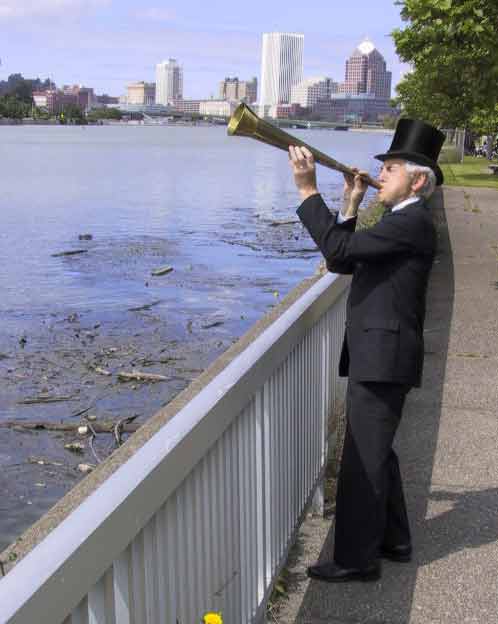
|